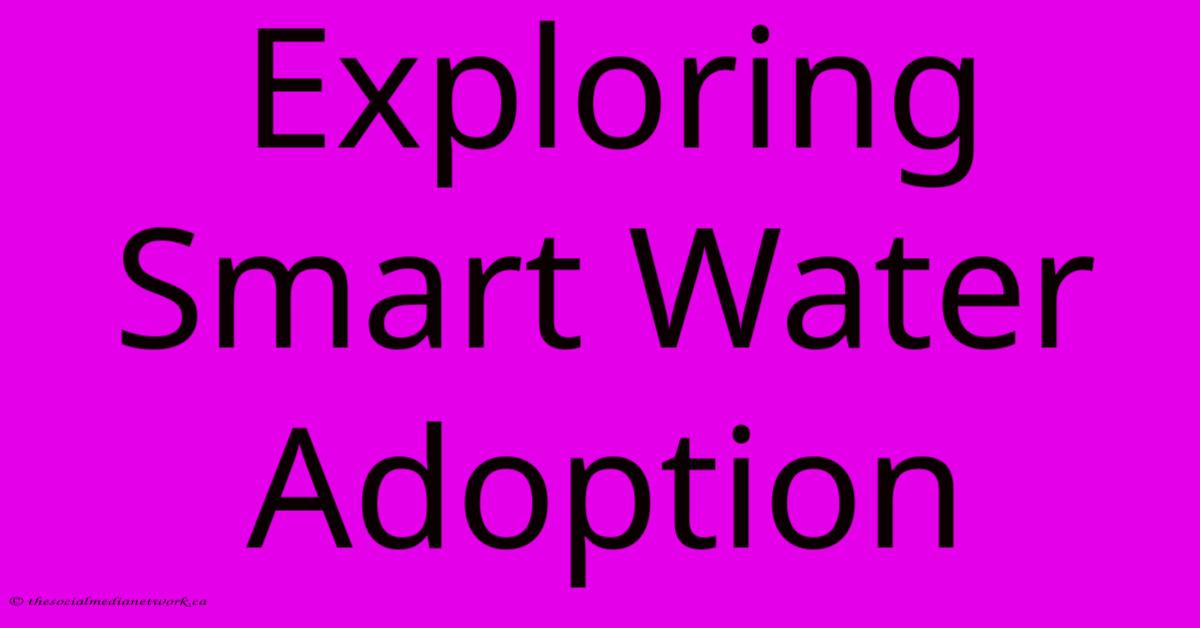Exploring Smart Water Adoption

Discover more detailed and exciting information on our website. Click the link below to start your adventure: Visit Best Website meltwatermedia.ca. Don't miss out!
Table of Contents
Exploring Smart Water Adoption: A Comprehensive Guide
The global water crisis is intensifying, demanding innovative solutions for efficient water management. Smart water technology offers a promising path forward, promising significant improvements in conservation, resource allocation, and overall infrastructure management. This article explores the burgeoning adoption of smart water solutions, examining the driving forces, challenges, and future potential of this transformative technology.
What is Smart Water Technology?
Smart water technology leverages a network of interconnected sensors, data analytics, and automation to optimize water usage and distribution. This sophisticated system monitors various parameters, including water levels, pressure, flow rates, and quality, providing real-time insights into the entire water cycle. This data-driven approach enables proactive management, minimizing water loss, detecting leaks promptly, and optimizing infrastructure performance. Think of it as giving your entire water system a brain and nervous system, allowing for precise control and efficient operation.
Key Components of Smart Water Systems:
- Smart Meters: These advanced meters accurately measure water consumption, providing granular data for improved billing and leak detection.
- Sensors and Monitoring Devices: Sensors placed throughout the water network monitor pressure, flow, and water quality, relaying crucial data to a central system.
- Data Analytics Platforms: Sophisticated software analyzes the collected data, identifying patterns, anomalies, and potential problems.
- Automated Control Systems: These systems automatically adjust water flow and pressure based on real-time data and pre-programmed rules.
- Leak Detection and Repair Systems: Smart systems rapidly detect leaks, pinpointing their location for faster and more efficient repairs.
Driving Forces Behind Smart Water Adoption
Several factors are fueling the increased adoption of smart water technologies:
- Growing Water Scarcity: Droughts and increasing populations are stressing water resources globally, necessitating more efficient water management strategies.
- Aging Water Infrastructure: Many regions grapple with aging water pipes and infrastructure, leading to significant water loss through leaks and bursts. Smart systems help pinpoint and address these issues proactively.
- Increasing Demand for Water Transparency: Consumers and regulatory bodies demand greater transparency and accountability in water management practices. Smart systems provide this transparency.
- Technological Advancements: Improvements in sensor technology, data analytics, and communication networks have made smart water solutions more affordable and reliable.
- Government Regulations and Incentives: Many governments are implementing regulations and offering incentives to encourage the adoption of smart water technologies.
Challenges to Widespread Smart Water Adoption
Despite its numerous benefits, several challenges hinder the widespread adoption of smart water technology:
- High Initial Investment Costs: Implementing smart water systems requires significant upfront investment in infrastructure and technology.
- Data Security and Privacy Concerns: The collection and management of sensitive water data raise concerns about security and privacy.
- Lack of Skilled Workforce: Operating and maintaining complex smart water systems requires a skilled workforce with expertise in data analytics and technology.
- Interoperability Issues: The lack of standardization across different smart water technologies can create interoperability problems.
- Public Awareness and Acceptance: Educating the public about the benefits of smart water technology and addressing concerns is crucial for successful adoption.
The Future of Smart Water: Opportunities and Predictions
The future of smart water looks bright, with several exciting developments on the horizon:
- AI and Machine Learning Integration: Integrating AI and machine learning into smart water systems will improve predictive capabilities, optimize resource allocation, and enhance leak detection accuracy.
- Advanced Sensor Technologies: The development of more advanced, low-cost, and energy-efficient sensors will expand the reach and capabilities of smart water systems.
- Improved Data Analytics and Visualization: Better data analytics tools and user-friendly dashboards will make it easier for water managers to understand and act on data.
- Increased Collaboration and Data Sharing: Collaboration among water utilities and data sharing initiatives will improve efficiency and resource optimization.
Conclusion:
Smart water technology is essential for addressing the global water crisis and ensuring the sustainable management of our precious water resources. While challenges remain, the benefits of improved efficiency, reduced water loss, and enhanced transparency far outweigh the obstacles. As technology continues to advance and costs decrease, the adoption of smart water solutions will undoubtedly accelerate, shaping a more sustainable and resilient future for water management worldwide.

Thank you for visiting our website wich cover about Exploring Smart Water Adoption. We hope the information provided has been useful to you. Feel free to contact us if you have any questions or need further assistance. See you next time and dont miss to bookmark.
Featured Posts
-
Kelantan Flood Relief Centers Activated
Nov 26, 2024
-
Jdt Aims To Extend Winning Streak Against Chinese Clubs
Nov 26, 2024
-
Korea Tragedy Jdts Cold Fear
Nov 26, 2024
-
Highlights 2024 Global Healthy Longevity Conference
Nov 26, 2024
-
Bayern Munich Psg Nov 26th Match Details
Nov 26, 2024
